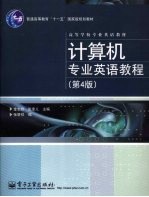图书介绍
计算机专业英语教程 第4版pdf电子书版本下载

- 金志权等主编 著
- 出版社: 北京:电子工业出版社
- ISBN:7121056461
- 出版时间:2008
- 标注页数:445页
- 文件大小:24MB
- 文件页数:456页
- 主题词:电子计算机-英语-高等学校-教材
PDF下载
下载说明
计算机专业英语教程 第4版PDF格式电子书版下载
下载的文件为RAR压缩包。需要使用解压软件进行解压得到PDF格式图书。建议使用BT下载工具Free Download Manager进行下载,简称FDM(免费,没有广告,支持多平台)。本站资源全部打包为BT种子。所以需要使用专业的BT下载软件进行下载。如 BitComet qBittorrent uTorrent等BT下载工具。迅雷目前由于本站不是热门资源。不推荐使用!后期资源热门了。安装了迅雷也可以迅雷进行下载!
(文件页数 要大于 标注页数,上中下等多册电子书除外)
注意:本站所有压缩包均有解压码: 点击下载压缩包解压工具
图书目录
Unit 1 Hardware I 1
1.1 A Closer Look at the Processor and Primary Storage 1
1 2 Bus Interconnection 7
1.3 Integrated Circuit—Moore's Law 13
1 4 Multicore Processors 17
1.5 CISC and RISC 20
1.6 Computer Architectures 22
Unit 2 HardwareⅡ 32
2.1 Optical Storage Media: High-Density Storage 32
2.1.1 Optical Laser Disks 32
2.1.2 DVDs 33
2.2 Display devices Smart cards 38
2 2.1 Display devices 38
2.2.2 Smart card—another type of storage system 40
2.3 RAID Technology 42
2.4 The External Interface: USB and FireWire 47
2 4.1 USB—Universal Serial Bus 48
2.4.2 FireWire Serial Bus 50
Unit 3 Programming 57
3.1 C++ and Object-Oriented Programming 57
3.2 JavaScript Tutorial 63
3.3 Introduction to Java 66
3.4 Advanced Visual C++ Features 69
3 5 Characteristics of Web Programming Languages 76
3.6 Parallelism and Compiler 81
3.7 Programmable Multifunction Timers 84
Unit 4 Operating System 89
4.1 Summary of OS 89
4.2 Using The Windows Operating System 92
4.3 Window Managers 99
4.4 Myths of UNIX 102
4.5 Using Linux in Embedded and Real-time Systems 104
Unit 5 Computer Networks 111
5.1 Internet 111
5.2 Type of Connection 119
5.3 Extending Your Markup: An XML Tutorial 125
5.4 Network Protocols 134
5.4.1 Protocol Hierarchies (Reading Material) 134
5.4 2 WAP—The Wireless Application Protocol 140
5.5 Web 2.0,Internet2 145
5.5.1 Web 2 0 145
5.5.2 Internet2 146
Unit 6 Network Communication 151
6.1 Two Approaches to Network Communication 151
6.2 Carrier Frequencies and Multiplexing 153
6.3 Wavelength Division Multiplexing: Ultra High Speed Fiber Optics 157
6.4 Gigabit Ethernet: From 100 to 1 000 Mbps 162
6.5 Wireless Network 171
Unit 7 Database 178
7.1 An Overview of a Database System 178
7.2 Introduction to SQL 182
7.3 Object-Oriented Database Management Systems 184
7.4 Object-relational Database 188
7.5 Data Warehouse 191
7.5.1 Data Warehouse 191
7.5.2 What is Data Mining? 195
7.6 Universal Data Access (UDA) Overview 199
Unit 8 Multimedia 205
8.1 Introduction 205
8.l.1 Main Properties of a Multimedia System 205
8.1.2 Multimedia 206
8.2 Audio 208
8.2.1 Computer Representation of Sound 210
8.2.2 Audio Formats 211
8.2.3 MP3 Compression 212
8.3 Video 215
8.3.1 Video Compression 215
8.3.2 MP4 218
8.4 Synchronization 222
8.5 An Introduction to Desktop Conferencing (Reading Material) 224
Unit 9 Artificial Intelligence 228
9.1 Overview of Artificial Intelligence 228
9.2 About Expert System 231
9.3 Introduction to Game AI 235
9.4 Computer Recognition of Speech 240
9.5 Neural Networks 243
9.6 Industrial Robotics (Reading Material) 249
Unit 10 Data Structure and Algorithms 256
10.1 Abstract Data Types and Algorithms 256
10.2 Heterogeneous Linked Lists 260
10.3 Block Sorting Algorithms: Parallel and Distributed Algorithm 263
10.4 Divide-and-Conquer 267
10.5 NP-Hard and NP-Complete Problems (Reading Material) 270
Unit 11 Fundamentals of the Computing Sciences 273
11.1 Predicates 273
11.2 Basic Concepts of Modern Algebra 276
11.2.1 Partially Ordered Sets (Posets) 276
11.2.2 Semigroups and Groups 282
11.3 Languages and Grammars 288
11.4 Finite-State Machines 292
11.5 Turing Machines 296
Unit 12 Computer Applications I 301
12.1 Computer-Aided Design 301
12.2 Introduction to CAM 304
12.3 Introductory Overview of CIM 309
12.4 Management Information System(MIS) 314
12.5 Geographic Information Systems(GIS):A New Way to Look at Business Data 316
12.6 Introduction to GPS 319
Unit 13 Computer Applications Ⅱ 325
13.1 Distance Education Technological Models 325
13.2 What is“Electronic Business”? 329
13.3 The Virtual Reality Responsive Workbench 334
13.4 Office Automation 341
13.5 E-Government—Introduction 342
Unit 14 Software Development 349
14.1 Overview of Software Engineering 349
14.2 UML in Action 352
14.3 Overview of the Capability Maturity Model 355
14 4 Requirements for the Next Generation Methods and CASE Environments 360
14.5 Agile Software Development Methods 365
Unit 15 Network Security 373
15.1 What Do I Need to Know about Viruses? 373
15.2 Modern Cryptography-Data Encryption 375
15.3 Firewalls and Proxies 379
15.4 Key Management Infrastructure/Public Key Infrastructure Introduction 383
Unit 16 Some Computer Systems 387
16 1 Embedded Systems 387
16.2 Distributed Systems 391
参考译文 399
1.3集成电路——摩尔定律 399
1.5 CISC和RISC 400
2.3廉价磁盘机冗余阵列技术 400
2.4.1通用串行总线 402
3.1 C十+和面向对象的程序设计 403
3.6并行性和编译程序 406
4.4 UNIX的神话 407
4.5在嵌入式和实时系统中使用Linux 408
5.6.1 Web 2.0 410
6.1网络通信的两种方法 411
6.5无线网络 411
7.1数据库系统概述 413
7.6通用数据访问(UDA)概述 415
8.3.1视频图像压缩 417
8.5桌面会议介绍 419
9.2专家系统 419
9.5神经网络 421
10.3块排序算法:并行和分布式算法 424
10.4分治法 425
11.1谓词 426
12.2 CAM介绍 428
12.5地理信息系统(GIS):查看事务数据的新方法 429
13.1远程教育技术模型 431
13.3虚拟现实响应工作台 432
14.2 UML在运转 434
14.4下一代方法和CASE环境的需求 436
15.2现代密码学——数据加密 437
15.3防火墙和代理 439
Bibliography 442